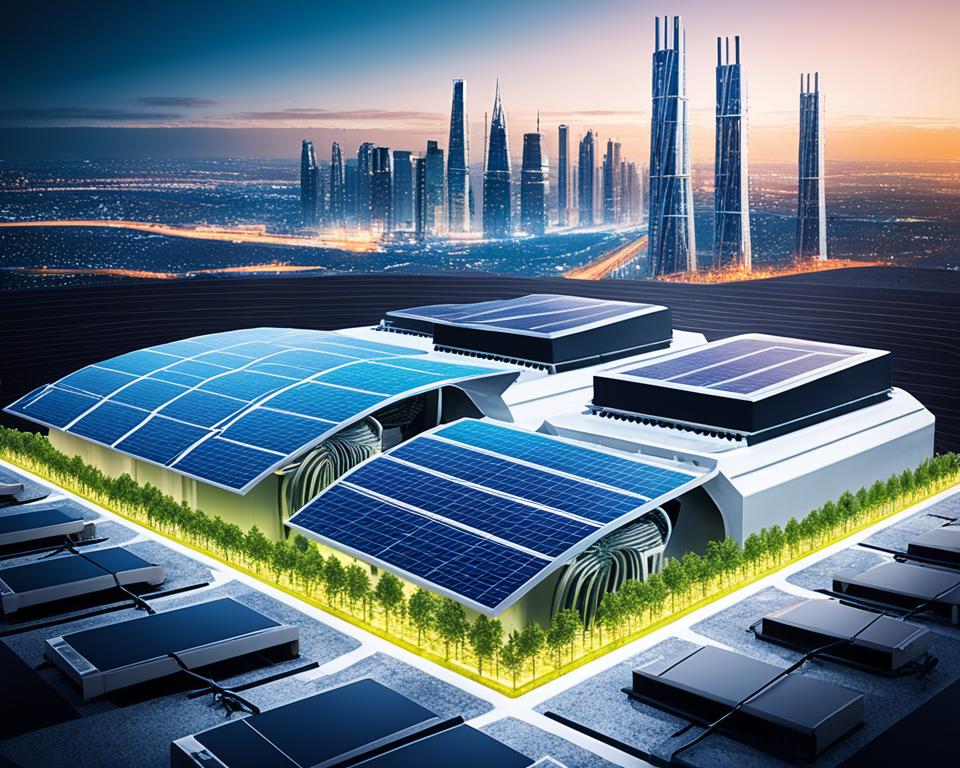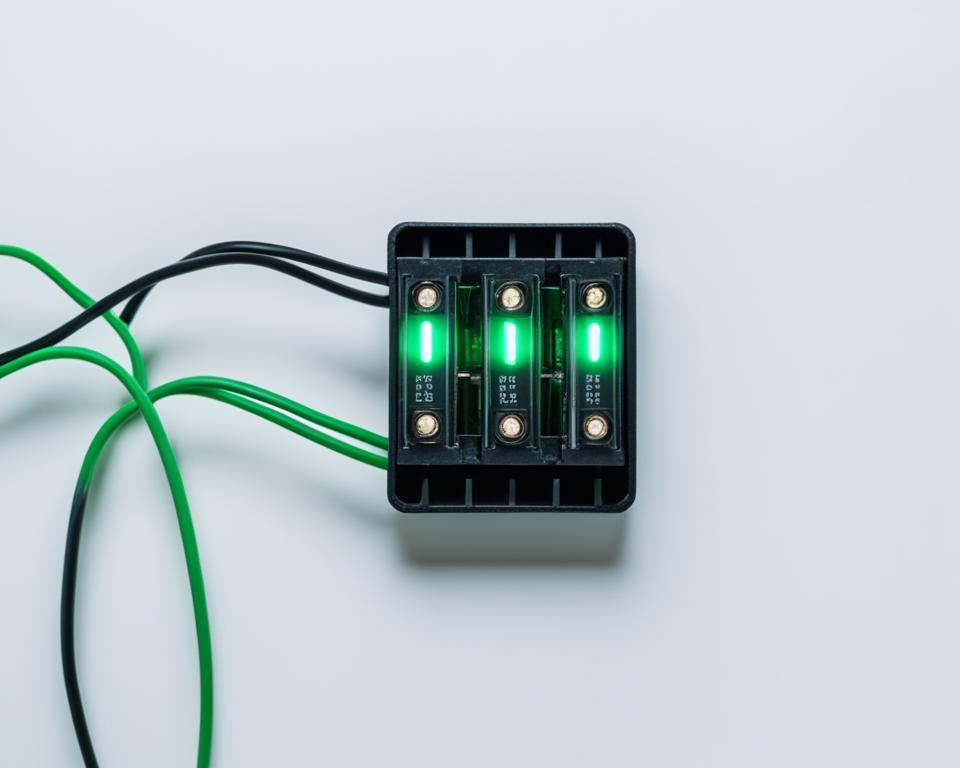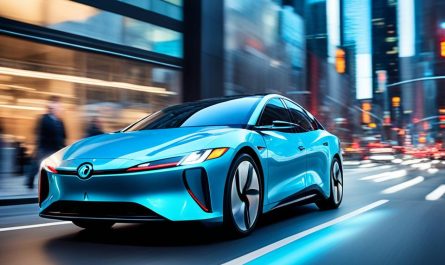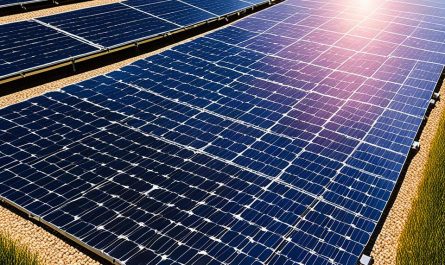The world of power electronics is always changing. We see a big need for efficient and flexible power conversion solutions. At the center of this change are DC to AC converters, also known as inverters. They are key in changing direct current (DC) into alternating current (AC).
These devices are vital for many uses, like renewable energy systems and uninterruptible power supplies (UPS). They make it possible to use electrical power smoothly and efficiently.
This article will cover the basics and real-world uses of DC to AC converters. We’ll look at why they’re important, how they work, and the different types out there. By diving into DC to AC power conversion, we’ll see how to make these systems work better and more efficiently.
Read interesting things at : grenzgamer
Key Takeaways
- DC to AC converters, also known as inverters, are essential devices that transform direct current (DC) into alternating current (AC) for various applications.
- These power conversion systems enable the efficient use of electrical power, from renewable energy sources to backup power supplies.
- Understanding the fundamentals of DC to AC conversion is crucial for designing and implementing effective power transformation solutions.
- Exploring the different types of DC to AC converters, their operating principles, and the factors affecting their performance is vital for making informed decisions.
- Optimizing the efficiency and safety of DC to AC converters is a key focus area, ensuring reliable and cost-effective power transformation.
Understanding the Fundamentals of DC to AC Conversion
Modern power systems rely on converting direct current (DC) to alternating current (AC). This process is done by dc to ac converters. It’s vital for making different power sources and devices work together smoothly. Whether it’s renewable energy, UPS, or home appliances, knowing how DC to AC conversion works is crucial.
What is a DC to AC Converter?
A dc to ac converter, or inverter, changes DC power from batteries or solar panels into AC. This AC can run a lot of AC-using devices, like motors, lights, electronics, and the power grid. The dc to ac inverter circuit is key in making this change, making sure the power is smooth and efficient.
The Importance of Power Transformation
Many electrical systems and devices need AC power, but some power sources like batteries give out DC. DC to AC converters fill this gap, letting DC power work with AC devices. This change makes different energy systems work together better, leading to more efficient power use.
For using renewable energy or keeping the power on without breaks, knowing about dc to ac power supply conversion is key. Learning about these devices helps us understand their big role in our energy future.
Principles of DC to AC Converter Operation
At the core of efficient power conversion are the fundamental principles of DC to AC converters. These principles are key to building reliable and high-performing systems. They come from the basics of power electronics and circuit design.
Successful DC to AC conversion depends on power electronics, switching circuits, and advanced control strategies. These elements work together to turn DC into high-quality AC. This AC is then ready for many applications.
Power Electronics and Switching Circuits
A DC to AC converter’s core is its power electronics circuitry. It includes semiconductors, capacitors, and inductors. These parts, arranged and controlled right, form the inverter circuit design. This design makes DC to AC conversion possible.
Switching circuits are key to this process. They quickly change the current flow. This turns the DC input into a high-frequency AC output. The timing and control of these switches are vital for the converter’s efficiency and reliability.
Control Strategies and Power Conversion Principles
Control strategies and power electronics work together in DC to AC conversion. These algorithms, often using microprocessors, manage the output’s amplitude, frequency, and waveform. They make sure the AC power is high quality.
Using principles like pulse-width modulation and advanced control, DC to AC converters improve power transfer. They also reduce losses and keep the AC output quality high. This is true even when the load or input voltage changes.
The blend of power electronics, switching circuits, and control strategies is crucial for efficient DC to AC conversion. It ensures reliable and high-performance power transformation for various applications.
Types of DC to AC Converters
Changing DC to AC is key in today’s power systems. DC to AC converters, or inverters, have different types for various needs. Single-phase and three-phase inverters are the main types used.
Single-Phase Inverters
Single-phase inverters are used in homes, businesses, and small industries. They turn a single DC input into AC, making them great for solar panels, UPS, and home devices. These inverters are simple, affordable, and efficient, making them a good choice for many uses.
Three-Phase Inverters
Three-phase inverters work with three DC inputs to produce three-phase AC outputs. They’re often found in big industries, like factories, renewable energy setups, and motor control systems. These inverters can handle more power and manage it better than single-phase ones, making them ideal for complex applications.
| Feature | Single-Phase Inverters | Three-Phase Inverters |
|---|---|---|
| Input | Single-phase DC | Three-phase DC |
| Output | Single-phase AC | Three-phase AC |
| Power Capacity | Lower | Higher |
| Efficiency | Relatively High | Improved |
| Applications | Residential, Commercial, Small-scale Industrial | Medium to Large-scale Industrial, Renewable Energy Systems, Variable-speed Drives |
Choosing between single-phase and three-phase inverters depends on the application’s needs. This includes the power needed, the system’s design, and the need for complex power management.
DC to AC Converter Topologies and Designs
The efficiency and performance of a DC to AC converter depend on its design and topology. There are two main types: voltage source converters and current source converters. Each has its own strengths and uses.
Voltage Source Converters
Voltage source converters (VSCs) are great for renewable energy and motor drives. They keep a steady DC voltage and adjust the AC voltage with techniques like pulse-width modulation (PWM). VSCs are known for their efficiency, quick response, and ability to handle power flow in both directions.
Current Source Converters
Current source converters (CSCs) keep a steady DC current and adjust the AC current. They’re used in high-power setups like HVDC systems and big industrial drives. CSCs are strong, tolerant to faults, and can handle a wide range of power factors.
Choosing the right DC to AC converter depends on the application, power level, voltage and current needs, efficiency, and cost. Designers must weigh these factors to pick the best dc to ac converter topologies for their projects.
| Comparison | Voltage Source Converters | Current Source Converters |
|---|---|---|
| Input Characteristic | Constant DC voltage | Constant DC current |
| Output Characteristic | Controlled AC voltage | Controlled AC current |
| Power Flow | Bi-directional | Typically unidirectional |
| Efficiency | Generally higher | Relatively lower |
| Applications | Renewable energy systems, motor drives | HVDC transmission, large industrial drives |
Choosing the right dc to ac converter topologies is key to a system’s performance and efficiency. It’s important for engineers to know the pros and cons of voltage and current source converters. This knowledge helps them make the best choices for their projects.
Applications of DC to AC Converters
DC to AC converters, also known as inverters, are key in many areas. They help mix DC power with AC grids and systems. This makes power conversion efficient and reliable.
Renewable Energy Systems
DC to AC converters are vital in renewable energy, like solar PV setups. Solar panels produce DC power that needs to be changed to AC. Solar inverters do this, making renewable energy useful for our power needs.
These converters boost the efficiency of renewable energy systems. They manage the DC power’s voltage and current. This ensures solar panels work at their best, giving us more renewable energy.
Uninterruptible Power Supplies (UPS)
DC to AC converters are also crucial in UPS for important systems and electronics. When the power goes out, a UPS uses a battery to keep things running. These converters change the DC power from batteries into AC power smoothly.
UPS converters give stable, reliable power during outages. This is vital for places like hospitals, data centers, and factories. They keep operations running without trouble.
| Application | Key Features of DC to AC Converters |
|---|---|
| Renewable Energy Systems |
|
| Uninterruptible Power Supplies (UPS) |
|
DC to AC converters help renewable energy and UPS work better. They make power use more efficient, reliable, and connected. This leads to a greener and stronger power system.
Inverter Circuits and Control Strategies
At the core of turning DC into AC are the complex inverter circuits and the smart control strategies that run them. The field of power electronics for inverters is always changing. Engineers and researchers are always finding new ways to make these devices better, more reliable, and more flexible.
Choosing the right design for inverter circuits is key. There are two main types: Voltage source converters and current source converters. Each has its own strengths and weaknesses. The best choice depends on the input voltage, what you need from the output, and the application.
The way DC to AC converters are controlled is also vital for their performance. Techniques like pulse-width modulation (PWM), space vector modulation (SVM), and feedback control help manage the output voltage, current, and frequency. This ensures the power conversion is efficient and stable.
| Inverter Circuit Topology | Control Strategies |
|---|---|
| Voltage Source Converters | Pulse-Width Modulation (PWM) |
| Current Source Converters | Space Vector Modulation (SVM) |
| Feedback Control Techniques |
Choosing the right control strategies for DC to AC converters greatly affects the system’s efficiency, power quality, and dynamic response. Designers must balance complexity, computational needs, and performance to optimize the control algorithms for their application.
Inverter circuits and their control strategies are crucial for many things like renewable energy, industrial motors, and reliable power supplies. By understanding and improving these components, engineers can make power conversion more efficient and reliable.
Power Conversion Efficiency and Optimization
At the core of a DC to AC converter is the power conversion efficiency. This measure shows how well the power is changed, affecting energy use, heat, and costs. It’s key for designers and users to know what affects efficiency and how to make it better.
Factors Affecting Efficiency
Many things can change a DC to AC converter’s efficiency. The design, the parts used, and how they handle heat are big factors. The choice of power semiconductors and their design, along with cooling systems, greatly affects efficiency. These elements can make the converter work better and last longer.
Techniques for Improving Efficiency
- Advanced Power Electronics: New power semiconductors like silicon carbide and gallium nitride boost switching and cut losses, making the dc to ac converter efficiency better.
- Optimized Circuit Design: A well-thought-out converter design, including the right passive parts, cuts losses and boosts efficiency.
- Improved Control Algorithms: New control methods, like advanced PWM and adaptive control, make switching patterns better and reduce harmonics, improving efficiency of dc to ac conversion.
- Thermal Management Solutions: Good cooling and design can lessen heat losses and keep the converter running at the best temperature.
By focusing on these factors affecting efficiency and using the right techniques for improving efficiency, designers can make DC to AC converters work better. This leads to better performance and savings in power electronics.
| Technique | Description | Efficiency Impact |
|---|---|---|
| Advanced Power Electronics | Using new semiconductor materials | Big boost in switching and less conduction loss |
| Optimized Circuit Design | Picking the right parts and design | Less loss and better efficiency |
| Improved Control Algorithms | Advanced PWM and adaptive control | Better switching and less harmonics |
| Thermal Management Solutions | Good cooling and design | Less heat loss and stable temperatures |
These strategies help designers aim for the best efficiency of DC to AC conversion. They make power electronics more reliable, cost-effective, and green.
“High power conversion efficiency is crucial for modern DC to AC converters. It affects the system’s performance, energy use, and the environment.”
Safety Considerations in DC to AC Converters
Using DC to AC converters is safe if you know the safety rules. These devices are key in many areas, like renewable energy and UPS systems. It’s important to understand the safety risks they bring.
DC to AC converters can be dangerous if not used right. They can cause electric shocks and fires. To avoid this, they must be properly grounded and insulated. It’s also key to have safety features like circuit breakers and fuses to prevent electrical problems.
Keeping DC to AC converters safe also means thinking about electromagnetic compatibility (EMC). These devices can disturb other electronics with electromagnetic interference (EMI). To fix this, they must meet EMC standards and use methods like shielding to reduce EMI.
| Safety Consideration | Importance |
|---|---|
| Electrical Hazards | Proper grounding, insulation, and overcurrent protection are essential to mitigate risks of electric shock and fire. |
| Electromagnetic Compatibility (EMC) | Compliance with EMC standards and implementation of EMI mitigation strategies are crucial to ensure safe and reliable operation. |
By focusing on these safety points, DC to AC converter makers and users can make sure these devices work well and safely. This helps make energy transformation technologies more popular and effective.
Emerging Trends and Future Developments
The demand for efficient power transformation is growing fast. This is making the DC to AC converter industry very exciting. We’re seeing new trends and developments that will change this technology for the better. They promise better performance, efficiency, and better work with advanced energy systems.
Power electronics are advancing quickly in DC to AC converters. Engineers are working on new semiconductor devices and control methods. These will make converters more efficient and powerful. They’re using materials like silicon carbide (SiC) and gallium nitride (GaN) for better performance.
Now, we’re also linking DC to AC converters with energy storage like batteries and supercapacitors. This helps use renewable energy sources like solar and wind better. It makes power systems more reliable and strong. Plus, smart control systems and data analytics help optimize these converters. They make maintenance easier and help balance the grid in real-time.
Smart grid technologies are making DC to AC converters more important. They help manage energy flow in both directions. This lets us use energy resources better and manage how we use energy. As smart grids grow, DC to AC converters will need to get smarter too. They’ll have to support new energy management strategies.
The future of DC to AC converters looks bright. Advances in power electronics and energy storage are leading to big changes in power transformation. As technology gets better, we’ll see more efficient and flexible DC to AC converters in the future.

“The future of DC to AC converters is filled with exciting possibilities as we continue to push the limits of power electronics and energy management technologies.”
Design Challenges and Solutions
Creating efficient DC to AC converters is tough. Engineers face big challenges in two main areas: thermal management and electromagnetic interference (EMI).
Thermal Management
High-power DC to AC converters get very hot. It’s key to manage this heat well to keep them running long and reliably. Engineers must think about how to cool them down effectively.
Here are some ways to handle the heat in dc to ac converter design challenges:
- Use advanced cooling like heatsinks, fans, and liquid cooling to get rid of heat.
- Plan the layout to help heat spread better and avoid hot spots.
- Choose materials that conduct heat well to help cool the converter.
- Use active cooling and keep an eye on temperatures to keep things running smoothly.
Electromagnetic Interference (EMI)
DC to AC converters can create a lot of electromagnetic interference. This can mess with other devices and systems. It’s important to fix this issue to keep converters working well and safely.
Here are some ways to tackle electromagnetic interference in dc to ac converter design challenges:
- Use shielding like metal boxes and grounding to keep electromagnetic fields in check.
- Plan the circuit and wires to avoid unwanted electromagnetic paths.
- Add EMI filters and components like common-mode chokes and capacitors to reduce emissions.
- Use new modulation and switching methods to cut down on high-frequency harmonics and EMI.
By solving these dc to ac converter design challenges, engineers can make sure these converters work well, efficiently, and safely in many applications.
| Design Challenge | Strategies |
|---|---|
| Thermal Management |
|
| Electromagnetic Interference (EMI) |
|
“Effective thermal management and EMI mitigation are critical to ensure the reliable and efficient performance of DC to AC converters in real-world applications.”
Practical Applications and Case Studies
DC to AC converters, also known as inverters, are key in many industries. They change DC power into AC, making energy use more efficient. Let’s look at some real examples and studies that show how these devices work in the real world.
Renewable Energy Systems
In renewable energy, DC to AC converters are crucial. They connect solar panels, wind turbines, and other sources to the power grid. These converters turn DC into AC, which can be used in the grid or for local power needs. This helps use more clean energy and supports renewable tech.
Industrial Automation and Control
DC to AC converters are also vital in industrial settings. They help control and run motors and other equipment. By making industrial processes more efficient, they save costs, boost productivity, and cut energy use.
Grid-Tied Energy Storage Systems
DC to AC converters are key in energy storage systems tied to the grid. They let energy storage systems work with the grid smoothly. This helps store and use energy when needed, making the grid more stable and resilient.
| Application | Benefits of DC to AC Converters |
|---|---|
| Renewable Energy Systems |
|
| Industrial Automation and Control |
|
| Grid-Tied Energy Storage Systems |
|
These examples show how DC to AC converters are used in many areas. As we need better power solutions, these converters will be more important. They will shape the future of energy, industry, and more.
“DC to AC converters are the unsung heroes of the modern power landscape, enabling the seamless integration of renewable energy, powering industrial automation, and ensuring grid stability.”
Selecting the Right DC to AC Converter
Choosing the right DC to AC converter is key for efficient power transformation and top performance. There are several important factors to think about when picking a converter.
Factors to Consider
First, figure out your power needs. Think about the input and output voltage, and the power rating you need. This helps you pick the right converter type and design.
Efficiency is also crucial. Look for converters with high efficiency to cut down on energy loss and lower costs. Don’t forget to consider the environment, like temperature and humidity, to make sure the converter works well where you plan to use it.
Size and weight of the converter matter too. Plus, think about any special features you might need, like protection or advanced control options.
Choosing the Appropriate Converter
After identifying your needs, you can look at different converters to find the right one. Compare models to see which fits best.
Talking to experts or manufacturers can also help. They can guide you on choosing the right converter and share the latest tech and trends. They can also suggest the best converter for your specific needs.
| Factor | Consideration |
|---|---|
| Power Rating | Ensure the converter can handle the required input and output power for your application. |
| Efficiency | Look for high-efficiency converters to minimize energy losses and operational costs. |
| Environmental Conditions | Consider the temperature, humidity, and other environmental factors that the converter will operate in. |
| Physical Size and Weight | Choose a converter that fits within the available space and meets weight requirements. |
| Special Features | Evaluate any additional functionalities or protection mechanisms that may be important for your application. |

By carefully looking at these factors and getting advice from experts, you can pick the right DC to AC converter for your needs. This ensures your power conversion system works efficiently, reliably, and performs well.
Maintenance and Troubleshooting
Keeping your DC to AC converter running well is key. It’s important to maintain and troubleshoot it right. Let’s look at how to keep your converter in great shape.
Recommended Maintenance Procedures
Checking your DC to AC converter often is a must. This means:
- Looking for any damage or wear
- Cleaning out dust and debris inside
- Checking cooling systems work right
- Replacing parts that wear out or don’t work
These steps help your converter last longer and work better.
Troubleshooting Techniques
When your converter has problems, follow a step-by-step plan. This includes:
- Looking for damage or loose parts
- Testing voltages and currents
- Checking control circuits and safety features
- Using tools to find the problem
- Fixing parts that don’t work
These methods help you find and fix issues fast, keeping your converter reliable.
| Maintenance Task | Frequency | Benefits |
|---|---|---|
| Visual Inspection | Monthly | Spot problems early, avoid failures |
| Cleaning | Quarterly | Helps cooling, lowers overheating risk |
| Component Replacement | Annually | Keeps performance high, extends life |
| Functional Testing | Bi-annually | Checks if everything works right, spots new issues |
Following these maintenance and troubleshooting tips helps your DC to AC converter last longer and work better. This means it stays reliable and efficient.
“Proper maintenance is the key to unlocking the full potential and longevity of your DC to AC converter.”
Conclusion
This article has covered the basics, how they work, and their uses in DC to AC converters. It showed the different types, their designs, and what affects their efficiency. Readers now know how important these devices are in changing power and managing energy.
We talked about new trends and future changes in DC to AC conversion. This shows how these technologies are always getting better. We also looked at real-world examples and how these converters are used in many areas. This includes renewable energy and backup power systems.
As we need better and more reliable power solutions, this article is a great guide. It highlights the benefits of using DC to AC conversion technology. The key takeaways from this deep dive into DC to AC converters help us understand their role in power transformation. They also show their many uses.



